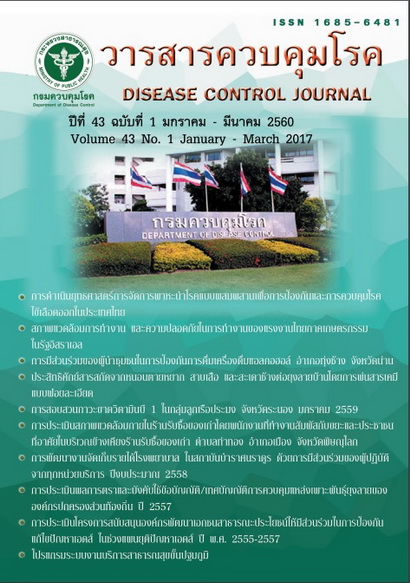Evaluation of the Project to Support for Non-governmental Organizations (NGOs) to participate in HIV prevention and alleviation during Ending AIDS strategy implementation between 2012-2014
DOI:
https://doi.org/10.14456/dcj.2017.39Keywords:
Non-Governmental Organizations (NGOs), HIV prevention, target group, networks, monitor and evaluationAbstract
This study is an quantitative and qualitative evaluative research of the project on funding support for NGOs based on the project indicators, including numbers of organizations involved, numbers of projects, project areas and types of activities that were implemented during 2012-2014. Data were collected from project reports and documents related to project management and administration. Data were analyzed by using frequency and percentage. It is found that each year the Department of Disease Control has received an approved fund of 50 million bahts to support NGOs and was able to fund 700 organizations or 700 projects with an average of 10 organizations or projects per province and per year. It can be concluded that this fund has been distributed to more NGOs that were in need and has covered all 77 provinces. Regarding activities, there will be a trend that more projects which are rather small will continue to receive funds while most of the small projects will emphasize HIV prevention. In this case, the activities included communication on risk behaviors, surveillance and screening, and HIV counseling and rapid testing to take patients into treatment at the earliest stage, especially with the target groups like youth and work force age groups between 15-24 years. They were young people outside schools, youth in communities, youth in juvenile detention centers, young prisoners under probation, youth in drug dependent centers, young labour workers in small factories in communities, men who have sex with men (MSM) in beauty salon shops, MSM in massage shops, and MSM in entertainment settings. The second emphasis in terms of activities was the support for entering into treatment system targeting AIDS patients who had been in the health system. Their activities were counselling, infor¬mation giving, self care, How to get infected by HIV and how HIV get transmitted to others, continuum care, continuum care at home, referral, seeking assistance and support, stigma reduction, and other areas related to treatment and care such as capacity development of networks, how to reduce if being affected, and learn¬ing exchange like changing attitude or perception among health or social workers, sexual health among ado¬lescents, and the subjects related to disease prevention and prevention from unwanted pregnancy and violence. The third emphasis in terms of activities were technical supports or strengthening networks and capacity development, including monitoring and evaluation and knowledge management to extend working models to others to learn from. Under this emphasis, the target groups were group leaders, peer groups or supervisors at hospital level, advisors at provincial level, committee members of Thai Networks of People Living with HIV and Thai NGO Coalition on HIV/AIDS at provincial, sub-national and national levels.
Downloads
References
2. วิพุธ พูลเจริญ, เครือข่ายนักวิชาการมูลนิธิสถาบันวิจัยและพัฒนานโยบาย. เคล็ดวิชาช่วยพัฒนาปูมประสิทธิผลโครงการเอดส์. กรุงเทพมหานคร: หนังสือวันดี; 2557.
3. คณะกรรมการองค์การพัฒนาเอกชนด้านเอดส์. สรุปบทเรียนการทำงานเอ็นจีโอเรื่องเอดส์. กรุงเทพมหานคร: คณะกรรมการองค์การพัฒนาเอกชนด้าน เอดส์; 2544.
4. กรมควบคุมโรค. ระเบียบข้อบังคับการจัดทำโครงการขององค์กรพัฒนาเอกชน. นนทบุรี: กรมควบคุมโรค; 2547.
5. สำนักโรคเอดส์ วัณโรค และโรคติดต่อทางเพศสัมพันธ์. หลักเกณฑ์การจัดสรรงบประมาณโครงการเงินอุดหนุนองค์กรเอกชนสาธารณประโยชน์ในการดำเนินการ ป้องกันแก้ไขปัญหาเอดส์. นนทบุรี: สำนักโรคเอดส์ วัณโรค และโรคติดต่อทางเพศสัมพันธ์; 2557.
6. สำนักโรคเอดส์ วัณโรค และโรคติดต่อทางเพศสัมพันธ์. สรุปสาระสำคัญผลการจัดสรรงบประมาณอุดหนุนโครงการย่อย โครงการเงินอุดหนุนองค์กรเอกชนสาธารณประโยชน์ในการดำเนินการป้องกันแก้ไขปัญหาเอดส์. นนทบุรี: สำนักโรคเอดส์ วัณโรค และโรคติดต่อทางเพศสัมพันธ์; 2557.
7. สถาบันพัฒนาการสาธารณสุขอาเซียน มหาวิทยาลัยมหิดล. ทำเนียบองค์กรพัฒนาเอกชนด้านเอดส์ในประเทศไทย ปี 2544. ม.ป.ท.
8. วีรสิทธิ์ สิทธิไตรย์. รายงานการสำรวจองค์กรพัฒนาเอกชนในภาคตะวันออกเฉียงเหนือและภาคเหนือ. กรุงเทพมหานคร: สภากาชาดไทย; 2539.
9. สุภาวรรณ แพรกทอง. สภาพแวดล้อมและกลไกการจัดการที่เกี่ยวข้องกับประสิทธิผลการสนับสนุนโครงการสนับสนุนองค์กรพัฒนาเอกชนให้มีส่วนร่วมในการป้องกันแก้ไขปัญหาเอดส์ งบอุดหนุนกรมควบคุมโรค ในช่วงปี 2545-2549. นครศรีธรรมราช: สำนักงานป้องกันควบคุมโรคที่ 11 จังหวัดนครศรีธรรมราช; 2552.
10. มูลนิธิกองทุนไทย. การประเมินผลองค์กรพัฒนาเอกชนคู่สัญญากับกระทรวงสาธารณสุขที่รับการสนับสนุนจากธนาคารโลก. กรุงเทพมหานคร: มูลนิธิกองทุนไทย; 2543.
Downloads
Published
How to Cite
Issue
Section
License
Articles published in the Disease Control Journal are considered as academic work, research or analysis of the personal opinion of the authors, not the opinion of the Thailand Department of Disease Control or editorial team. The authors must be responsible for their articles.






